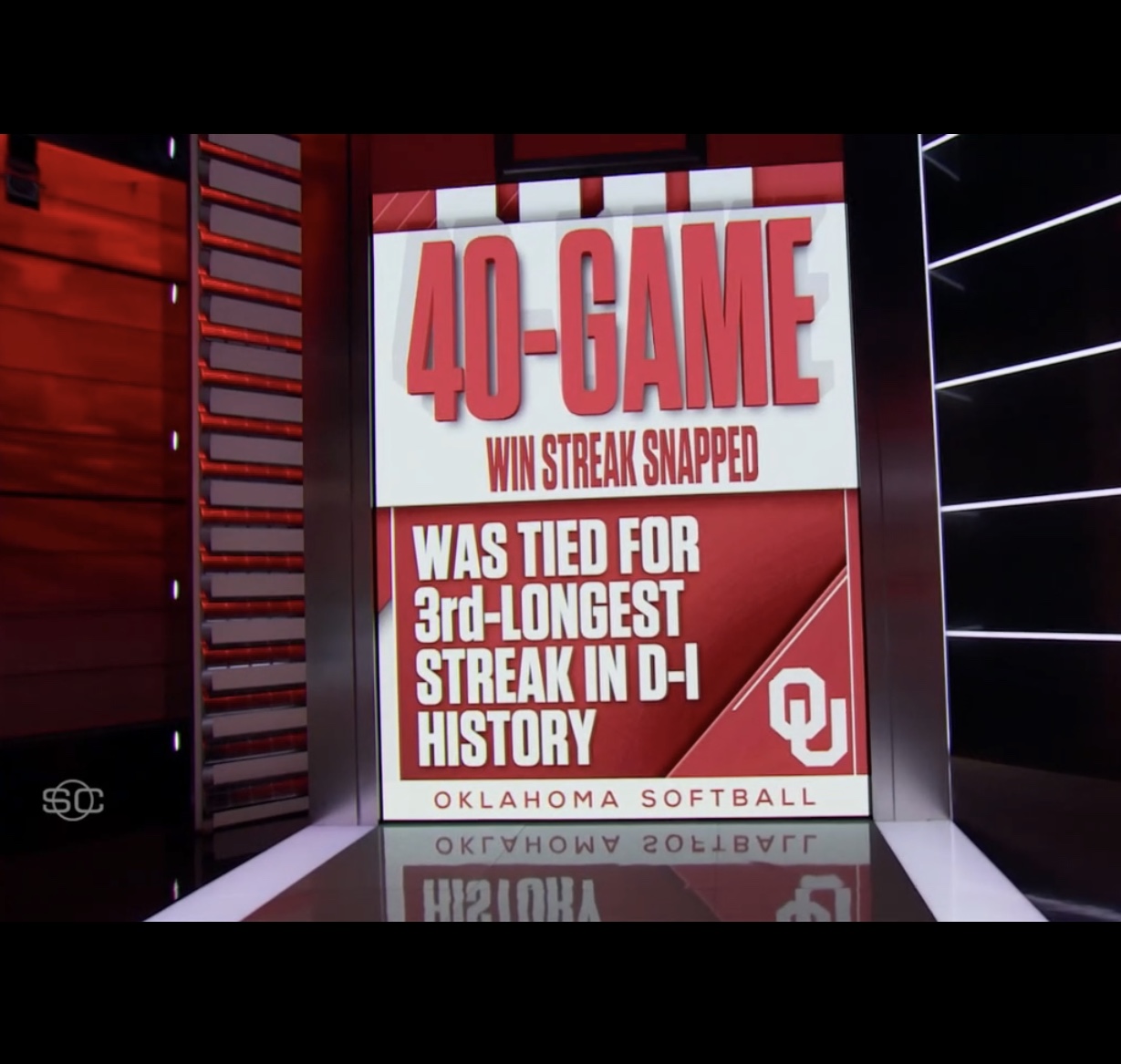
Texas pitcher, Hailey Dolcini allowed just two (2) hits Saturday when facing OU, the undefeated, #1 team in college softball.
The right hander only struck out three (3) Sooners, hit two batters AND DID NOT ISSUE ANY WALKS.
Her effort came two days after she gave up just three (3) hits and only two earned runs in a 3-0 series-opening loss to Oklahoma.
Boasting the nation’s top offense, Oklahoma (38-1) entered the series averaging 9.83 runs per game. The Sooners had a Division 1 leading .392 batting average, but just hit .100 against Dolcini in the two games.
Before I ask “WHAT JUST HAPPENED” – a little context & perspective. I first want to acknowledge how special a 40 GAME WINNING STREAK IS. Wow!
The reason I was always skeptical of the question: ”what happened” was because softball and baseball are NOT games of ”perfection”; in fact, quite the opposite, they are games of FAILURE, especially hitting.
Hitting is NOT a ”controllable event” like shooting a free-throw. You can do everything right in hitting and still only hit .300 and be an All-Star, which means you failed 7 (seven) out of 10 times. Still, as hitters and hitting coaches, we seek perfection and solutions.
Also, on this forum, we ask questions to generate positive hitting discussions so others can learn and share vicariously on their own personal journeys. In that spirit, it is always OK to ask, WHAT JUST HAPPENED.
Pitchers, like my wife, will say, ”good pitching beats good hitting”; hitters will say, ”hitters need to make better adjustments”; twitter will blame the umpire’s zone or talk about how Cat’s pre-game celebration was a distraction or after 8 years of OU dominating Texas in the series, it was inevitable. It’s probably a little bit of everything.
Let’s dive in.
After the game, when Cat Osterman (color analyst for L.H.N. who got her Texas jersey number retired before the game on her birthday & U.S.A. gold medal pitcher) interviewed Dolcini; she prefaced her question by saying she “observed subtle adjustments” that Dolcini made from game 1 to game 3, then asked her “what did you do differently?” Her answer was something like this: trying to keep the screw LOWER in the zone and making sure my curve missed off of the plate away and did not stay over the plate.
In other words, Dolcini’s intent was to stretch the strike zone as much as possible east to west. In the two video clips above, in the very first inning, she gets Olo to pop up on the curve away, and gets a swing & miss on the screwball, low & in.
After going back and rewatching the entire game, that is exactly the pitch pattern she followed and executed over and over again. Mike White, coach for Texas, said in his in-game interview that the goal was to keep the OU hitters “guessing”.
I wanted somebody to ask J.T. & Coach Gasso the same question after the game – “how did Dolcini shut down the best offense in the country?” I’m sure they would tip their hat to Dolcini; acknowledge that the game is tough to play and not as easy as their hitters have made it look during the 40 game win streak; & then take responsibility for getting back to work and getting better.
Dolcini’s velocity was between 61-64 m.p.h.; she basically mixed the low screw with the curve; but her command was not perfect – she missed over the plate multiple times. The Sooners did not strike out except for 3 times; but never seemed to figure out how to ADJUST to what Dolcini was doing.
I guarantee that the OU hitters were prepared and knew exactly what Dolcini’s repertoire was and how she was going to attack them.
The next questions are: WAS IT DOLCINI’S ”STUFF”, Mike White’s game plan & pitch calling, or OU’s hitters’ swing mechanics &/or approach? At Swing Attractors, we discuss the latter: swing mechanics.
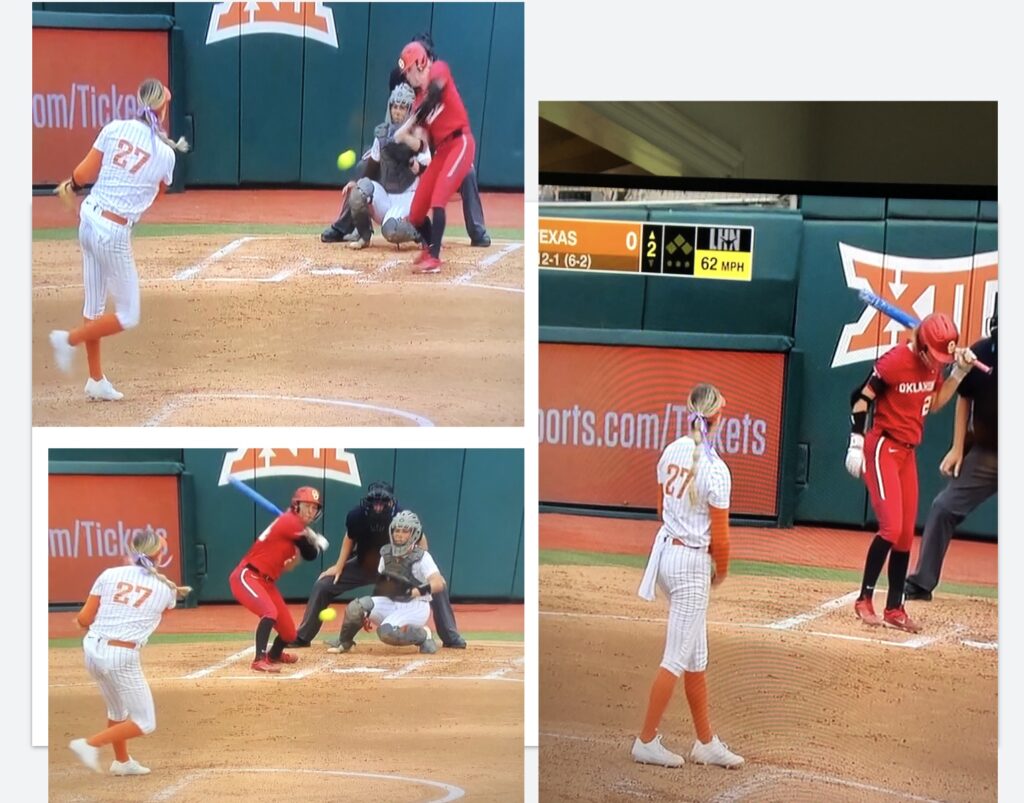
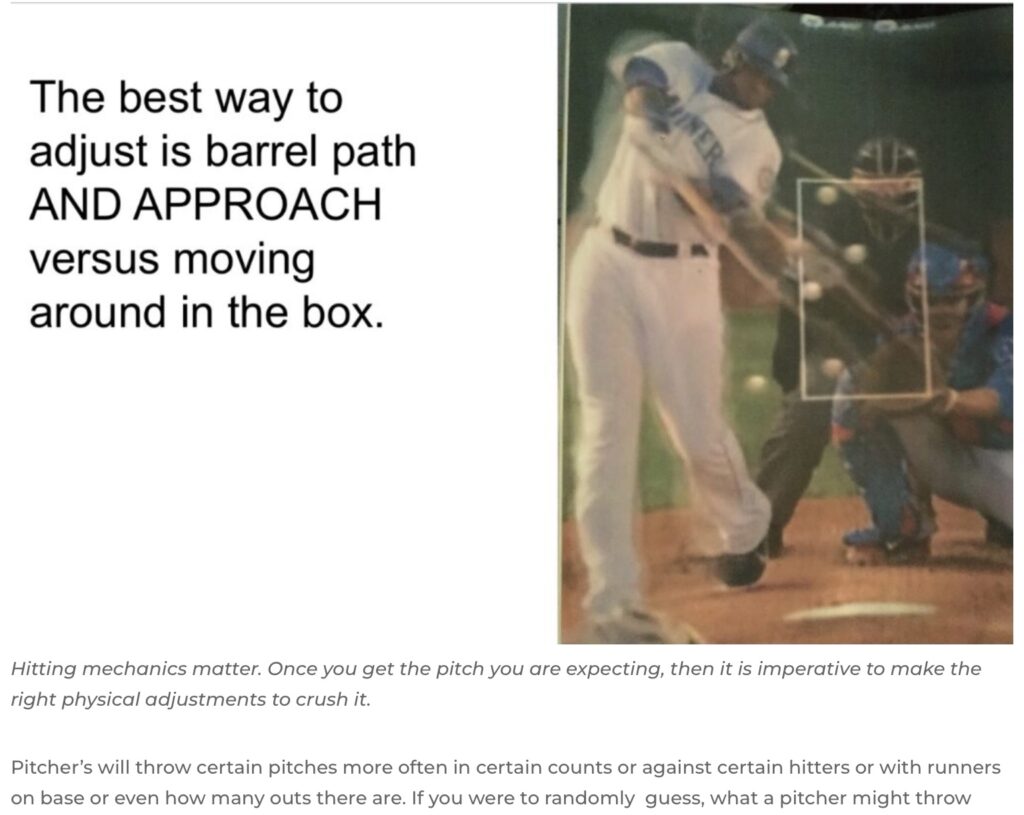
Above is a photo and quote from a previous Swing Attractor article that goes to the heart of this topic:
What’s your plan to attack a pitcher throwing east to west?
Hitting mechanics matter.
Hitters have to be able to HIT pitches that are BORDER LINE STRIKES FOR POWER.
If the pitch is in the quadrant that you are LOOKING FOR, you should be able to be on time and barrel it up and hit it for power. That’s what OU does & has been doing so far all of this season. Once you get the pitch that you are expecting, then it is imperative to make the right physical adjustments to ”crush it”.
The hitter’s body NEEDS to have some ”mechanism”/motor program for each quadrant. This ”mechanism” rapidly gets the hip turn velocity to maximum, then links it up to the torso, then decelerates it to get transfer momentum.
A hitter’s goal is to:
- BE ON TIME WITH THE PITCH YOU ARE ANTICIPATING;
- BE DECISIVE IN YOUR HITTING APPROACH – trust your preparation;
- BE DIRECT WITH YOUR MECHANICS & BARREL PATH;
- MATCH THE BARREL PLANE WITH THE SPIN OF THE PITCH;
- GET TO YOUR SPOT WITH POWER – don’t let the pitcher beat you;
- ONE SWING PER AT BAT ON A PITCH THAT YOU ARE ANTICIPATING & PUT YOUR BEST SWING ON IT.
What is your plan for attacking a pitcher who is throwing 63-65 m.p.h.; a screwball that is kept low in the zone; a curveball that is off of the plate a majority of the time; and a chase riseball?
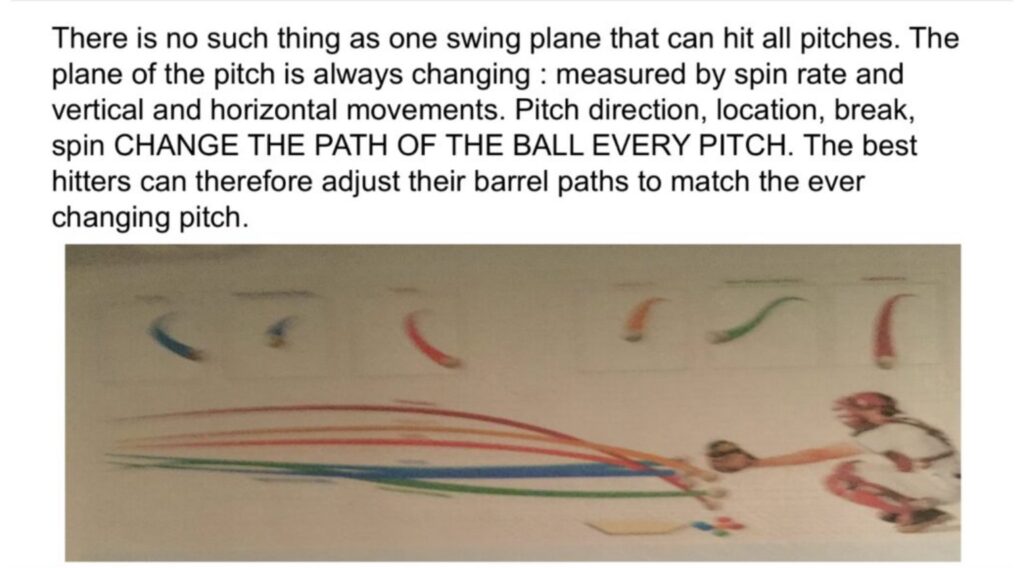
It’s the question I posed in last week’s article, ”can a hitter have the same swing rhythm and cover 17-20 inches east to west (the entire 17 inches of home plate plus an extra 3-4 inches for the width of the softball)?
If a hitter knows BEFORE THE PITCH IS THROWN, that they are looking for/sitting on/hunting/anticipating inside ONLY, WHAT PHYSICALLY WOULD YOU DO DIFFERENTLY?
- When would you start to rotate your lumbo-pelvic-spine in relationship to the pitch location?
- What would your posture look like compared to an outside pitch? Any difference?
- Can/would you time the launch and degree of your torso turn and/or handpath radius?
- Would you predetermine the degree and timing of the setting up of the axis of rotation?
- Would you feel a difference in the amount or timing of your stride/weight shift/linear coil?
- Are you going to adjust your posture whether it is the degree of the bend at the waist, or when/how you create your torso angle or spine angle based on location of the pitch, or to get on plane with the pitch?
- Are you ”comfortable handling” velocity on the inside half of the plate?
- Or do you have a tendency to want to ”hurry up” and ”get your foot down early”?
- How does your swing rhythm change, if any, for inside versus outside locations?
These questions can help a hitter optimize her/his physical &/or mechanical methods of adjustments that work best for them.
Motor programs are built of pieces which have alternatives to slightly alter swing shapes and timing. Each hitter has to figure out through practice and preparation which motor program to use and how to match the motor program/mechanisms that best fits a certain pitch – in this case, the low screwball.
Let’s take a look at some side by side still frames of MLB hitters hitting inside versus outside:
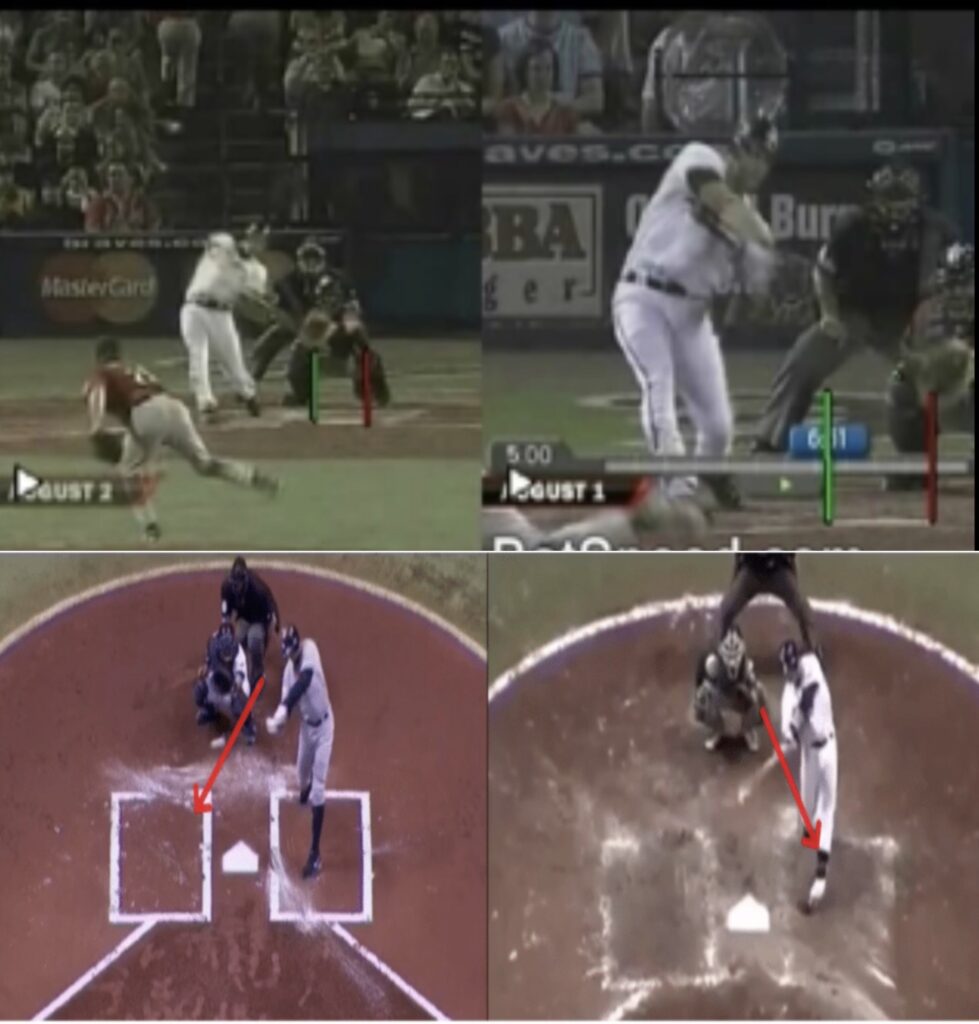
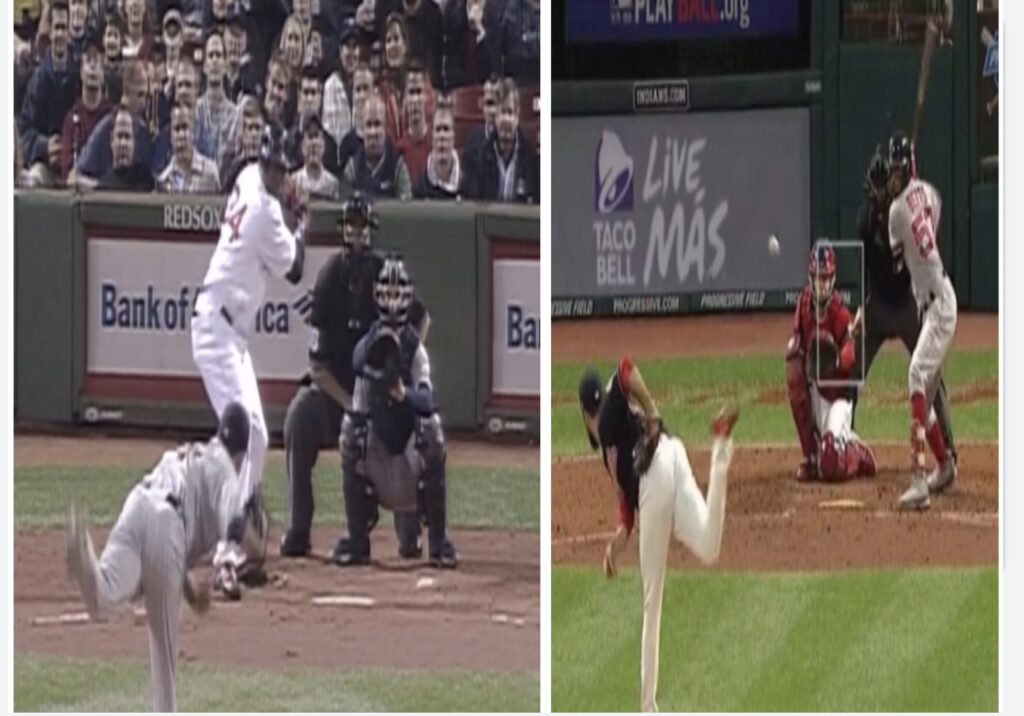
There are some commonalities but it seems each hitter finds the specific mechanism &/or motor program based on some of the questions asked above that suits him/her best.
What was OU’s physical adjustment to handle down & in?
Dolcini’s command was really good, but no way perfect. She missed over the heart of the plate multiple times. She threw first pitch strikes a majority of the time; she only threw a total of 99 pitches in the game; most of the at-bats were four (4) pitches or less.
https://m.youtube.com/shorts/D5qMzNOwvfY
I’m certain that each OU batter got at least one pitch per at bat from Dolcini that they expected and were ”looking for” and anticipating. After this series, I’m left wondering:
- What was OU’s specific plan &/or physical adjustment to handle the low screwball?
- Did the physical adjustment involve more than just moving further off of the plate?
- If yes, what did that physical adjustment entail?
- Were any of the OU hitters ”uncomfortable” with Dolcini’s velocity, spin, release, etc?
- During their 40 game winning streak, I’m sure other teams and pitchers tried the same pitching game plan against the OU hitters? What other pitchers attacked them predominantly east to west?
- Why was Dolcini successful this past weekend, while others were not?
- Are there any trends developing on OU hitters and reason for concern; or is this just a blip/one game to throw away and burn the video and blame it on Cat’s birthday?
Either way, it’s a lesson for our hitters too and questions for all of us to ask ourselves that have a passion for the art & skill of hitting.
As pitchers get more technical with technology and data and precision, so must hitters. Baseball and softball hitters have to get better too at making the right physical adjustments to hit the pitch they are expecting in all quadrants of the zone.
The game within the game is to follow along and see what adjustments OU hitters make to their motor programs & what comes next. This ”blip”/loss may be a blessing in disguise. A lot of this ”stuff” is trial & error, and growth from failure. Stay tuned!
When ADJUSTABILITY starts to happen more and more often, and MOTOR PROGRAMS ARE PRACTICED & DEVELOPED for specific pitches, then it will be time to start talking about moving the outfield fences back — but when hitters really understand & execute adjustability, it will not matter.
Good hitters should always beat good pitchers!
(Remember, I coached with my All American pitcher wife, who totally disagrees with me!).
PURSUE EXCELLENCE & WIN THIS PITCH!
About the Author

Mike Lotief coached 17 successful years as either the head softball coach or co-head softball coach with his wife Stefni Whitton Lotief at the University of Louisiana from 2002-2017 with an overall coaching record of 731-176 (80.6 winning percentage). Every season, the Ragin Cajuns softball team advanced to the NCAA tournament and also advanced to three (3) Women’s College World Series (2003, 2008, 2014) and from 2012-2016 advanced to five (5) straight NCAA Super Regionals. Coach Lotief produced over 40 All American selections and his 2017 team lead the nation in scoring and was ranked in the Top 10 in home runs, slugging percentage, on base percentage.
The coach is a cancer survivor (twice) and was the first person in the U.S. to receive the Pro Trach device. Mike and Stefni spearheaded and raised the funding to build the new softball stadium in 2009 and the new softball indoor hitting facility in 2015. They are proud parents to Chelsea, who played softball and graduated from the Univ. of Louisiana in 2018, and Andrew, who is a junior at Louisiana studying Mechanical Engineering.
Previous Articles in this Series
- The Mental Swing Attractors: Failure Cannot Break You (Nov. 11, 2021)
- Training Insights: “Swing Attractors” by Coach Mike Lotief… the Flaws of Pelvic Loading (Nov. 9, 2021)
- The Mental Swing Attractors: Push Yourself… You Don’t Have to Be #1 to BE #1! (Nov. 4, 2021)
- Training Insights: “Swing Attractors” by Coach Mike Lotief… Pelvis Loading, Part 2—The Planes of Movement (Nov. 2, 2021)
- The Mental Swing Attractors: Remove the Rope from Your Ankle & Get Rid of the Limiting Beliefs! (Oct. 28, 2021)
- Training Insights: “Swing Attractors” by Coach Mike Lotief… Pelvis Loading, Part 1—It’s All in the Hips (or Somewhere Deep Below) Oct. 26, 2021
- The Mental Swing Attractors: Champions are Developed by Devotion & Discipline! (Oct. 21, 2021)
- Training Expertise: “Swing Attractors”… the Secrets of Power Hitting by Coach Mike Lotief (Oct. 19, 2021)
More About Mike Lotief
- Why Michael Lotief is a Legendary Coach? by Jay Patel
- The Secret To Michael Lotief’s Success. By Jay Patel
- Michael Lotief Fights for Rajin’ Cajuns by Graham Hays ESPN
- Michael Lotief: Taking His Sport to New Heights by Neha Kapoor
- For the Love of the Game: A Look at Ragin’ Cajun Softball’s Power Couple
- How Louisiana-Lafayette’s Michael Lotief Develops Hitting Gems by Graham Hays ESPN
